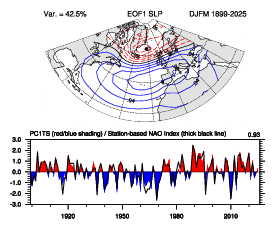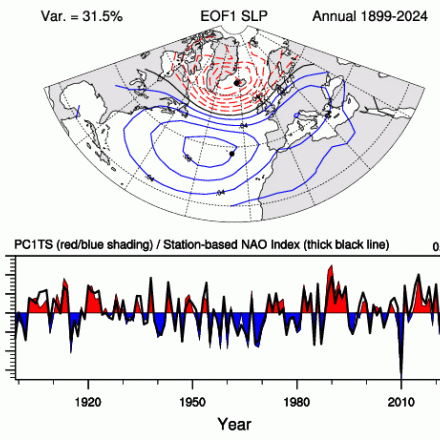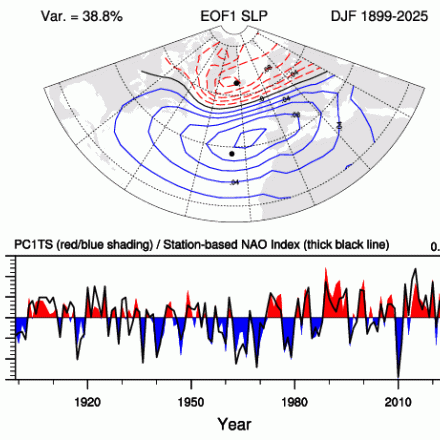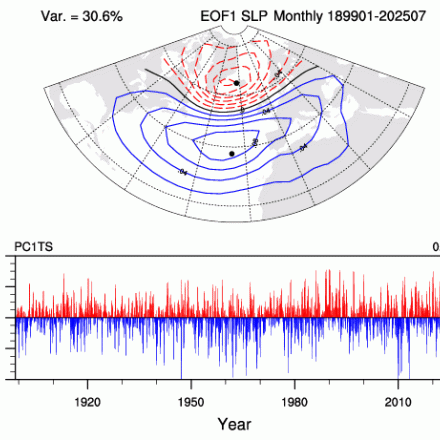Hurrell North Atlantic Oscillation (NAO) Index (PC-based)

The principal component (PC)-based indices of the North Atlantic Oscillation (NAO) are the time series of the leading Empirical Orthogonal Function (EOF) of SLP anomalies over the Atlantic sector, 20°-80°N, 90°W-40°E. These indices are used to measure the NAO throughout the year, tracking the seasonal movements of the Icelandic low and Azores high. These movements are illustrated in the Figures on this page. Positive values of the NAO index are typically associated with stronger-than-average westerlies over the middle latitudes, more intense weather systems over the North Atlantic and wetter/milder weather over western Europe.
Key Strengths
PC-based indices are more optimal representations of the full spatial patterns of the NAO
May be less noisy than station-based indices
Key Limitations
Not available as far back as station-based indices
Dependent on any inherent weaknesses in the source data set and its gridding scheme
- Annual North Atlantic Oscillation Index (PC-Based)
Missing Value
-999Units
standard deviationUpdated Through
2024-12-31Next Update
2026-05-01Start Date
1899-01-01File Notes
As is the nature of PC-based indices, every time additional data is used to compute the EOF the individual PC values will likely change. It is thus recommended that one downloads an entire climate index each time they wish to update their holdings.CAS Citation
NAO Index Data provided by the Climate Analysis Section, NCAR, Boulder, USA, Hurrell (2003). Updated regularly. Accessed DD Month YYYY [list date you accessed the data]. - DJF North Atlantic Oscillation Index (PC-Based)
Missing Value
-999Units
std.dev.Updated Through
2025-02-28Next Update
2026-05-01Start Date
1899-01-01File Notes
As is the nature of PC-based indices, every time additional data is used to compute the EOF the individual PC values will likely change. It is thus recommended that one downloads an entire climate index each time they wish to update their holdings.CAS Citation
NAO Index Data provided by the Climate Analysis Section, NCAR, Boulder, USA, Hurrell (2003). Updated regularly. Accessed DD Month YYYY [list date you accessed the data]. - DJFM North Atlantic Oscillation Index (PC-based)
Missing Value
-999Units
std.dev.Updated Through
2025-03-31Next Update
2026-05-01Start Date
1899-01-01File Notes
As is the nature of PC-based indices, every time additional data is used to compute the EOF the individual PC values will likely change. It is thus recommended that one downloads an entire climate index each time they wish to update their holdings. The DJFM PC index value for year N refers to an average of December year N-1 and January, February, and March year N SLP values prior to the EOF calculation. (Example: The 1999 PC value was based on the average of December 1998 and January, February, and March 1999 SLP values.)CAS Citation
NAO Index Data provided by the Climate Analysis Section, NCAR, Boulder, USA, Hurrell (2003). Updated regularly. Accessed DD Month YYYY [list date you accessed the data]. - JJA North Atlantic Oscillation Index (PC-Based)
Missing Value
-999Units
std.dev.Updated Through
2024-07-31Next Update
2026-05-01Start Date
1899-01-01File Notes
As is the nature of PC-based indices, every time additional data is used to compute the EOF the individual PC values will likely change. It is thus recommended that one downloads an entire climate index each time they wish to update their holdings.CAS Citation
NAO Index Data provided by the Climate Analysis Section, NCAR, Boulder, USA, Hurrell (2003). Updated regularly. Accessed DD Month YYYY [list date you accessed the data]. - MAM North Atlantic Oscillation Index (PC-Based)
Missing Value
-999Units
std.dev.Updated Through
2025-05-31Next Update
2026-08-01Start Date
1899-01-01File Notes
As is the nature of PC-based indices, every time additional data is used to compute the EOF the individual PC values will likely change. It is thus recommended that one downloads an entire climate index each time they wish to update their holdings.CAS Citation
NAO Index Data provided by the Climate Analysis Section, NCAR, Boulder, USA, Hurrell (2003). Updated regularly. Accessed DD Month YYYY [list date you accessed the data]. - Monthly North Atlantic Oscillation Index (PC-Based)
Missing Value
-999Units
std.dev.Updated Through
2025-07-31Next Update
2026-04-10Start Date
1899-01-01File Notes
As is the nature of PC-based indices, every time additional data is used to compute the EOF the individual PC values will likely change. It is thus recommended that one downloads an entire climate index each time they wish to update their holdings. The first column is the year, the second column holds January values, the third holds February values, etc., and the last column holds December values.CAS Citation
NAO Index Data provided by the Climate Analysis Section, NCAR, Boulder, USA, Hurrell (2003). Updated regularly. Accessed DD Month YYYY [list date you accessed the data]. - SON North Atlantic Oscillation Index (PC-Based)
Missing Value
-999Units
std.dev.Updated Through
2024-11-30Next Update
2026-05-01Start Date
1899-01-01File Notes
As is the nature of PC-based indices, every time additional data is used to compute the EOF the individual PC values will likely change. It is thus recommended that one downloads an entire climate index each time they wish to update their holdings.CAS Citation
NAO Index Data provided by the Climate Analysis Section, NCAR, Boulder, USA, Hurrell (2003). Updated regularly. Accessed DD Month YYYY [list date you accessed the data].
Expert Developer Guidance
Since there is no unique way to define the spatial structure of the NAO, it follows that there is no universally accepted index to describe the temporal evolution of the phenomenon. Most modern NAO indices are derived either from the simple difference in surface pressure anomalies between various northern and southern locations, or from the PC time series of the leading (usually regional) EOF of sea level pressure (SLP). Many examples of the former exist, usually based on instrumental records from individual stations near the NAO centers of action, but sometimes from gridded SLP analyses. A major advantage of most of these indices is their extension back to the mid-19th century or earlier.
A disadvantage of station-based indices is that they are fixed in space. Given the movement of the NAO centers of action through the annual cycle, such indices can only adequately capture NAO variability for parts of the year. Moreover, individual station pressures are significantly affected by small-scale and transient meteorological phenomena not related to the NAO and, thus, contain noise.
An advantage of the PC time series approach is that such indices are more optimal representations of the full NAO spatial pattern; yet, as they are based on gridded SLP data, they can only be computed for parts of the 20th century, depending on the data source.
For a more detailed discussion of issues related to the NAO indices and related indices such as the Northern Annular Mode (NAM) and Arctic Oscillation (AO), see Hurrell and Deser (2009) and Hurrell et. al (2003), linked in Key Publications 2 and 3 below.
- James Hurrell, NCAR
Technical Notes
The PC-based NAO indices produced by NCAR's Climate Analysis Section are based on Hurrell (2003), cited below. They are currently offered as ascii text files for winter, monthly, seasonal, and annual values. As is the nature of PC-based indices, every time additional data is used to compute the EOF the individual PC values will likely change. It is thus recommended that one downloads an entire climate index each time they wish to update their holdings.
The NCAR Sea Level Pressure dataset is used for the calculation of the various NAO PC-based indices.
Cite this page
Acknowledgement of any material taken from or knowledge gained from this page is appreciated:
Hurrell, James &, Phillips, Adam & National Center for Atmospheric Research Staff (Eds). Last modified "The Climate Data Guide: Hurrell North Atlantic Oscillation (NAO) Index (PC-based).” Retrieved from https://climatedataguide.ucar.edu/climate-data/hurrell-north-atlantic-oscillation-nao-index-pc-based on 2025-12-21.
Citation of datasets is separate and should be done according to the data providers' instructions. If known to us, data citation instructions are given in the Data Access section, above.
Acknowledgement of the Climate Data Guide project is also appreciated:
Schneider, D. P., C. Deser, J. Fasullo, and K. E. Trenberth, 2013: Climate Data Guide Spurs Discovery and Understanding. Eos Trans. AGU, 94, 121–122, https://doi.org/10.1002/2013eo130001
Other Information
- Hurrell, J.W., 1995: Decadal Trends in the North Atlantic Oscillation: Regional Temperatures and Precipitation. Science: Vol. 269, pp.676-679
- Hurrell, J. W., and C. Deser, 2009: North Atlantic climate variability: The role of the North Atlantic Oscillation. J. Mar. Syst., 78, No. 1, 28-41
- Hurrell et al. (2003) in The North Atlantic Oscillation: Climate Significance and Environmental Impact, 2003. J.W. Hurrell, Y. Kushnir, G. Ottersen, and M. Visbeck, Eds. Geophysical Monograph Series, 134, 279pp.
- Trenberth, K.E., and J.W. Hurrell, James W., 1999: Comment on:"The Interpretation of Short Climate Records with Comments on the North Atlantic and Southern Oscillations". Bulletin of the American Meteorological Society: Vol. 80, No. 12, pp.2721-2722





